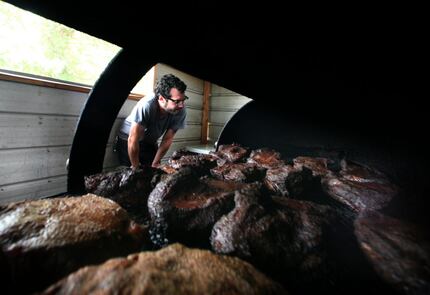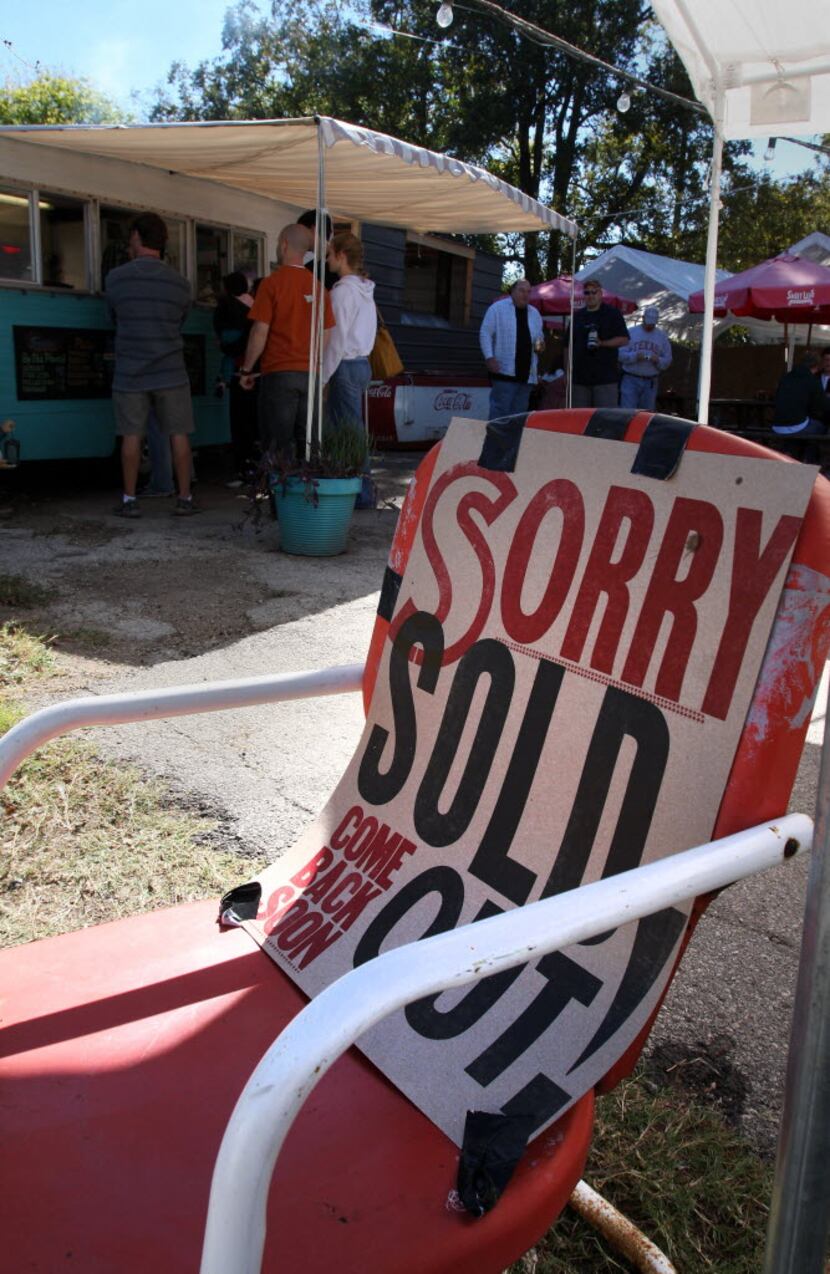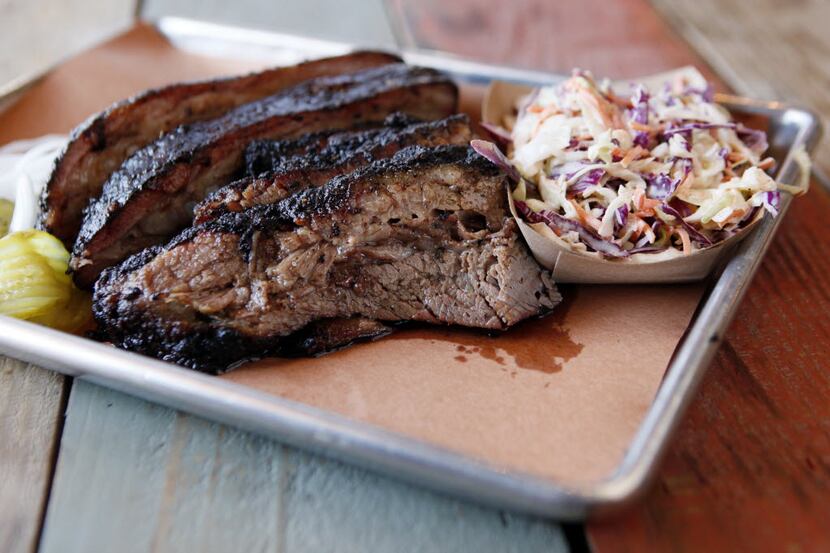This is not a brisket recipe.
You can find thousands of those online and in cookbooks, and each of them will give you guidelines as to how to spend a dozen or so hours smoking a fatty hunk of meat.
Instead, these are brisket tips from some of the Lone Star State's most knowledgeable brisket cookers. They shared their secrets during Camp Brisket, a two-day intensive workshop for 60 beef-obsessed people. (For more on Camp Brisket, click here.)
You are not going to be a brisket master on the first try.
“The barbecue tradition is taking meat and making it delicious through a time-consuming process,” says Texas food writer Robb Walsh. But because factors such as outdoor temperature, wind and fire can be so volatile, smoking brisket takes time. Be patient as you learn your pit and the science of barbecue.
Know your wood.
Texas barbecue experts disagree on which wood smokes brisket best. Popular options are post oak, mesquite, hickory and pecan, and Camp Brisket lets attendees taste briskets smoked with each. Wood does make a difference in how your brisket will taste, so experiment with them. Ask your favorite pitmasters what they use, too.
Fat is a good thing. But you’ll need to trim some of it off.
Aaron Franklin of Franklin Barbecue in Austin recommends cutting off as much as 30 percent of the entire weight of the brisket. “Good fat is flavor,” Franklin explains. Good fat will keep a brisket moist while it cooks. “But bad fat: That’s bad fat.” And it has to go.
Your mission while trimming off fat is to make the fat layer even, about 1/4-inch thick. If you’re at a barbecue joint, a good bite of brisket should include some rendered fat. When you order, ask for “moist” slices and you’ll get the pitmaster’s best.
Start with salt and pepper for your rub.
Central Texas barbecue purists believe only salt and pepper should be used in your brisket rub, says Texas meat writer Jess Pryles. Some restaurants add paprika or chili powder and swear by it. Try smoking a few briskets with salt and pepper first if you’re a card-carrying Central Texan.
It’s easier to make a fire hotter than to cool it off.
Much of the secret to smoking brisket is keeping a consistent temperature for many hours while it cooks. Managing your flame is the key. Pitmasters suggest easing into your fire; you can always stoke it to spike the temperature. It’s much harder to bring a raging fire’s temperature down. A finished brisket should have an internal temperature somewhere between 195 and 215 F, depending on its size.
Track your results each time you smoke a brisket.
Every pitmaster at Camp Brisket has kept notes of how they succeeded and failed smoking briskets at differing temperatures, at various lengths of time and with varieties of wood. Learn from your mistakes; it’s part of the fun.
You will not be excommunicated from the barbecue fraternity if you use a temperature probe. Restaurants use these all the time!
Best bet might be to leave a probe in your brisket so you can check temperatures without continually opening the pit. Speaking of …
Don’t open another man’s (or woman’s) pit.

This is where things get personal: Your barbecue pit is your business. You’ve been tending to that fire and saying prayers to the barbecue gods since the middle of the night, most likely. The worst thing someone could do is walk up and open the lid, messing with that temperature you’re trying to keep consistent, says Jeff Savell, meat science professor at Texas A&M.
To wrap or not to wrap?
That’s a big question. Pitmasters disagree on whether a brisket should be wrapped in peach paper -- a pinkish-brown kind of butcher paper -- or whether it should continue to smoke unwrapped. The potential advantage of wrapping a brisket about 3/4 through the total smoking time is it locks in the moisture and helps keep the temperature consistent for the remainder of the cook. Those who don’t wrap say it doesn’t make a difference in the end.
If you do choose to wrap, using aluminum foil at home is a good Plan B if Amazon.com can’t bring you peach paper in time. (Those in the know call wrapping in foil the “Texas crutch.”) New pitmasters might want to try both methods and record the results.
Let your brisket rest.
So your brisket has smoked for many hours, it’s developed a nice pepper crust we call bark, and it’s time to come out of the smoker. Time to eat, right? No way. Let that piece of meat rest for as short as an hour, as long as a few. Home cooks can put their brisket in a cooler and close the lid. Franklin keeps his briskets in a warmer at a resting temperature of 137.5 F. You probably can’t keep it at that kind of specific temperature, so do your best to aim for 140 F or so.
Don’t slice your brisket until you’re ready to eat it.
Sliced brisket deteriorates with every passing second. So don’t lose too much time Instagramming your perfect piece; it’s time to eat! To test whether you’ve smoked it according to Central Texas barbecue standards, slice a piece the width of a No. 2 pencil and hold it up. It shouldn’t fall apart but should separate easily if you pull it, says Franklin.
Texas brisket shouldn’t need sauce, but don’t let that stop you.
Central Texas pitmasters generally like to let the flavor of the meat shine, and a sugary or vinegary sauce can mask that flavor. But here’s the reality: You might like sauce. You also might’ve overcooked your brisket and sauce might add some extra moisture. Don’t let the apparent rules of Central Texas barbecue change the way you like to eat.
Follow Sarah Blaskovich on Twitter at @sblaskovich.


